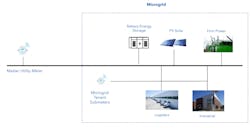Large Area Microgrid Planning – Lots of Moving Parts
A large area microgrid is a complex engineering, planning and construction undertaking. A large area microgrid typically may be a military facility or higher education campus, but increasingly large area microgrids are serving ambitious industrial and commercial real estate developments where the local utility may not have adequate capacity to serve the development or cannot provide capactiy at the pace of the development buildout.
As a solution, a large area microgrid can bridge the gap between what a utility can deliver and when a developer needs it delivered. A large area microgrid can also provide combinations of benefits ranging from on-site renewable energy, energy storage, infrastructure for extensive electric vehicle charging and firm power resiliency that often are desirable to both the developer and the utility.
Load modeling – it starts with the spreadsheet
Nothing gets moving until a model of the microgrid host's energy needs is developed. The site host or developer will have a buildout plan depicting various types of buildings on the project site. These buildings may be light industrial, logistics, health care, data center, etc., with each building having its own energy needs that collectively roll up into a site energy profile and site energy demand.
The role of the utility
At the risk of heresy, it can be helpful to think of the local utility as an integral partner in developing a large area microgrid. The utility has a charter and is typically incentivized to support large scale development. From that point of view, the utility can be a partner. Its role as a critical stakeholder is hard to understate.
In the first phone call, the utility will want to know the obvious: How much electric load does the microgrid need? Seems simple enough but from this initial point of departure, the whole process gets more complicated. Establishing how much juice is needed, the utility will then assess what its local infrastructure can support – or not. For a large load demand, on-site generation within the microgrid can be a benefit to both the developer and utility.
The physical infrastructure to connect is only one part of the engagement. There is also the commercial component of utility engagement. For instance, what tariff will the interconnection come under? What riders apply? Which riders are negotiable?
The point at which the developer engages the utility can have a significant bearing on how the development proceeds. Early and often is a good rule but engage with a plan. If the developer doesn’t have a plan, the utility will most assuredly have a plan for the developer.
DER mix, inverters and system metering
A large area microgrid with a significant portion of the on-site distributed energy system devoted to inverter-based generation – photovoltaic (PV) solar, battery storage, fuel cells – presents unique technical challenges. In the dash to the new, old school synchronous generation has a critical role to serve in forming a microgrid and for microgrid stability.
A recent study of microgrid control strategies conducted by the National Renewable Energy Laboratory models microgrid distributed energy resource (DER) combinations of synchronous generation, battery energy storage and PV solar. The study concludes that microgrids with mixed synchronous generation plus battery systems plus solar have the best transient and steady-state stability voltage and frequency control. Not unsurprisingly, the study depicts that engine generators and grid forming battery capacity aids in transient and steady-state stability.
In addition to the right DER mix, the microgrid will require an extensive network of power meters and a robust SCADA system. The larger the physical network area, the greater the number of buildings, the higher the cost of this network. But without this network of meters and communication fiber, the microgrid can’t be adequately controlled.
For economic reasons a robust network of power use submetering is also highly desirable.
Electrical infrastructure
Stating the obvious, the larger the site the higher the electrical infrastructure cost. But within the bounds of the site are multiple opportunities to design the physical infrastructure in a way that spends money prudently. From the configuration of the primary grid connecting substation, to the amount of copper in the ground, to the switching architecture, to optimizing the service level unit substations and on into phased construction, large area microgrid infrastructure is complex and a poor plan can be expensive.
Planning for a large area microgrid has many moving parts. Modeling the site utility loads, engagement with local utility, selection of the DER mix, designing a microgrid architecture and electrical infrastructure optimization are essential to ensuring the success of a large area microgrid.
Michael Boswell is vice president of power and infrastructure at Concord Engineering.









